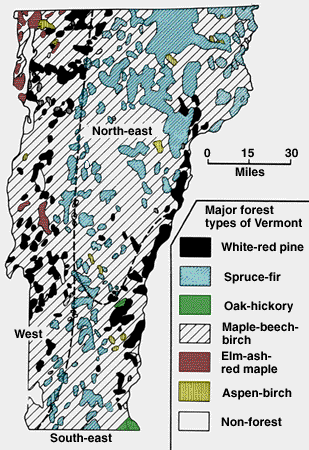


This map of Vermont shows the major forest types and the three
climactic divisions. (Based on Kingsley, N. P. 1977. The forest resources of Vermont. U.S.
Department of Agriculture Forest Service Bulletin NE-46. Northeast Forest Experimental
Station, Upper Darby, Penn.)

What are the long-term and large-scale effects of observed changes in tree growth?

Model projections of 60 years of unmanaged and managed forest growth for Vermont show few differences in total volume attributable to individual species' growth rate changes. However, shifts in size and age structure of species did occur, with the sugar maple being particularly susceptible. Thus, the economic analysis of effects of tree growth changes must include species-specific differences.

Dale, V. H. and R. H. Gardner. 1987. Assessing regional impacts of growth declines using a forest succession model. Journal of Environmental Management 24:83-93.
Dale, V. H., H. I. Jager, R. H. Gardner, and A. E. Rosen. 1988. Using sensitivity and uncertainty analysis to improve predictions of broad-scale forest development. Ecological Modeling 42:165-178.
Integrated Assessment Briefs. 1995. ORNL/M-4227. Oak Ridge National Laboratory, Oak Ridge, TN.